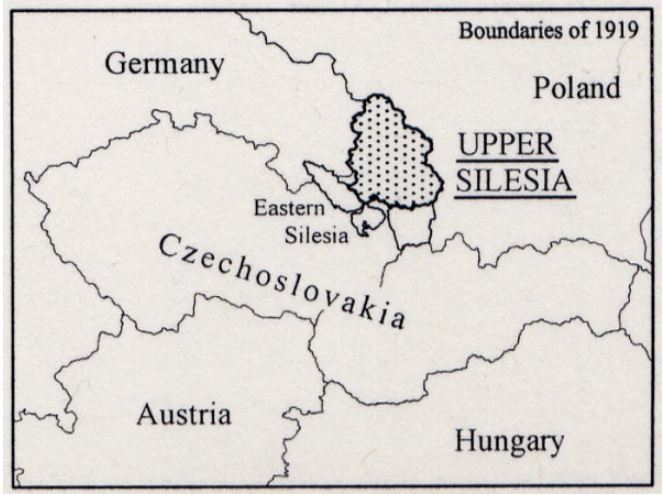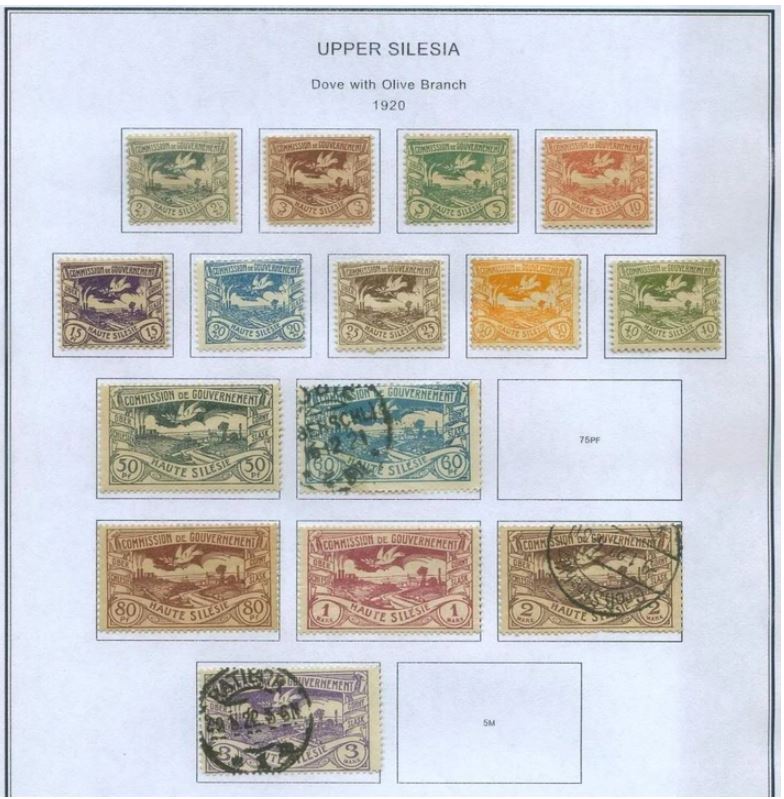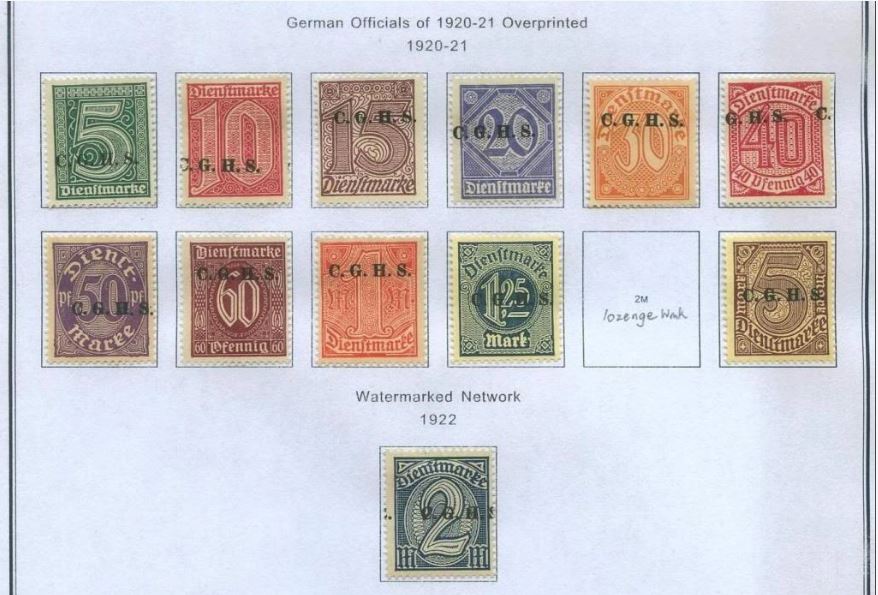rod222
Member 
Posts: 11,104  What I collect: Worldwide Stamps, Ephemera and Catalogues
What I collect: Worldwide Stamps, Ephemera and Catalogues
|
Post by rod222 on Apr 25, 2014 21:28:14 GMT
Scott Catalogue: Formerly in eastern Germany and prior to World War I a part of Germany. A plebiscite held under the terms of the Treaty of Versailles failed to determine the status of the country, the voting resulting about equally in favor of Germany and Poland. Accordingly, the League of Nations divided the territory between Germany and Poland. 100 Pfennig = 1 Mark 100 Fennigi = 1 Marka Maps: Author BC of "The Stamp Forum". Used with permission.    |
|
rod222
Member 
Posts: 11,104  What I collect: Worldwide Stamps, Ephemera and Catalogues
What I collect: Worldwide Stamps, Ephemera and Catalogues
|
Post by rod222 on Apr 25, 2014 21:46:59 GMT
C.G.H.S. Overprint = Commission de Gouvernment Haute Silesia (Upper Silesia)  |
|
Deleted
Deleted Member
Posts: 0
|
Post by Deleted on Apr 26, 2016 20:40:56 GMT
In 1919, after WWI the eastern part of Prussian Upper Silesia (with a majority of ethnic Poles) came under Polish rule while the mostly German-speaking western part remained part of the Weimar Republic as the newly established Upper Silesia Province. From 1919-1921 three Silesian Uprisings occurred among the Polish-speaking populace of Upper Silesia. In the Upper Silesia Plbicite of March 1921, a majority of 59,4% voted against merging with Poland and a minority of 40,6% voted for, with clear lines dividing Polish and German communities. The exact border, the maintenance of cross-border railway traffic and other necessary co-operations, as well as equal rights for all inhabitants in both parts of Upper Silesia, were all fixed by the German-Polish Accord on East Silesia, signed in Geneva on May 15, 1922. The 1921 overprints Sc 33-42       Scott and others note that there are forgeries - unusual that someone would turn a $0.25 stamp into a $20 one  I am submitting a likely candidate, genuine left, unknown right   The main key is the shape of the "9" and how close together the "9 & 2" are The 9 has a large upper oval with the bottom curve almost touching the oval |
|
tobben63
Member  Stamp eat sleep repeat
Stamp eat sleep repeat
Posts: 1,874  What I collect: I collect to much, world wide!
What I collect: I collect to much, world wide!
|
Post by tobben63 on Sept 1, 2018 19:01:23 GMT
I had no idea of this land/area. But in one of my stockbooks from this spring auction raid, I came over these 6 stamps. Another area to collect   |
|
hrdoktorx
Member 
Posts: 7,259
What I collect: France (and French territories), Africa, Canada, USA, Germany, Guatemala, stamps about science, flags, maps, stamps on stamps...
|
Post by hrdoktorx on Aug 24, 2020 20:55:09 GMT
So the goodies in the cardboard envelope were my auction winnings for last month, and the big piece is this Upper Silesia stamp, AFA #10a, 5pf overprint on 15pf purple, type I, on piece, SON cancel, proofed:  |
|
ausbrasilien
Member  Inactive
Inactive
Posts: 103  What I collect: German Area
What I collect: German Area
|
Post by ausbrasilien on Oct 24, 2020 1:00:09 GMT
Does anyone know how the division betwwen Eastern Silesia and Upper Silesia was set for the Plebiscites? was one area formely German and the other formerly Austrian-Hungarian?
Thank you in advance for any help!
|
|
Beryllium Guy
Moderator 
Posts: 5,917  What I collect: Worldwide Stamps 1840-1930
What I collect: Worldwide Stamps 1840-1930
|
Post by Beryllium Guy on Oct 24, 2020 6:58:13 GMT
Thanks for your post, ausbrasilien . A quick web search on the history of Upper & Eastern Silesia turns up a lot of information, some of which seems quite detailed. From what I could see, one of the best sites would seem to be this one: www.stamp-collecting-world.com/uppersilesiaplebiscite_history.htmlThis is an article titled Upper Silesia Plebiscite: A Brief History, but it seems quite extensive and covers not only Upper Silesia, but mentions Eastern Silesia, too. There is also an index for many other subjects related to the history of Germany, which may also be of interest to you. I hope this helps a little.   
Edit: I noticed after making this post that it seems that the article I found also gives attribution to Wikipedia, so that may be the primary source of its information. |
|
ausbrasilien
Member  Inactive
Inactive
Posts: 103  What I collect: German Area
What I collect: German Area
|
Post by ausbrasilien on Oct 24, 2020 14:51:04 GMT
Thanks for your post, ausbrasilien . A quick web search on the history of Upper & Eastern Silesia turns up a lot of information, some of which seems quite detailed. From what I could see, one of the best sites would seem to be this one: www.stamp-collecting-world.com/uppersilesiaplebiscite_history.htmlThis is an article titled Upper Silesia Plebiscite: A Brief History, but it seems quite extensive and covers not only Upper Silesia, but mentions Eastern Silesia, too. There is also an index for many other subjects related to the history of Germany, which may also be of interest to you. I hope this helps a little.   
Edit: I noticed after making this post that it seems that the article I found also gives attribution to Wikipedia, so that may be the primary source of its information. Thanks for your response Berylium Guy, I am really struggling to understand the Silesia question, I normally like to write little historic explanations that you don't normally find either in catalogues or albuns in presentation pages of my albuns and I am really puzzled about Silesia. I believe the region wasdivided in the Silesian wars at the time of frederick the great, but what happened after I can't find... I will check the www.stamp-collecting-world.com/uppersilesiaplebiscite_history.htmlThank you! |
|
gmot
Member 
Posts: 205
What I collect: Canada & French Morocco
|
Post by gmot on Oct 24, 2020 16:25:41 GMT
Upper Silesia - yes, was part of Prussia then Germany until after WWI. Then after the war it was divided into German/Polish sections as a result of the post-war plebiscite. Now the entire area is part of Poland as part of the post-WWII shift of German/Polish lands westwards.
Eastern Silesia - this is a separate area, was actually part of the Austro-Hungarian empire until after WWI. In its case, it was divided between Czechoslovakia and Poland as a result of its 1920 plebiscite. That division hasn't changed (I believe) since then.
A fascinating part of postal history - along with other plebiscite areas such as Marienwerder. (I used to collect them all but am selling what I have off as I narrow my focus).
|
|
ausbrasilien
Member  Inactive
Inactive
Posts: 103  What I collect: German Area
What I collect: German Area
|
Post by ausbrasilien on Oct 24, 2020 17:12:47 GMT
I found some useful information on my research of today.
Border changes throughout history
Silesia does not have clear natural boundaries hence the fluctuations of the region throughout history with boundary changes around the peripheries.
It is a region originally known to have been populated by multiple ethnic groups including Germanic tribes in the 1st century and clans of Slavonic background in the 6th century. It seems, despite its aspirations, it never managed to found its own state and be a truly independent political entity with the usual national trappings of a logo of some sort such as a flag, coat-of-arms, national anthem, etc. Its culture has been influenced by various ethnic and national groups. It might best be described as a borderland between western and eastern Europe. Its location has resulted in a complicated and tumultuous history that resembles series of continuous wars and take-overs by opportunist surrounding dynasties. It has experienced radical border changes and national affiliations over its history with very little independent political history. It has been calved up and tossed around between hereditary noble houses (monarchies, principalities, duchies, etc), and later, by modern nation states. Historically, it has been a battleground because of its geographical location between Germanic and Slavic people, its considerable coal deposits, and the struggle between Catholicism and Protestantism.
|
|
ausbrasilien
Member  Inactive
Inactive
Posts: 103  What I collect: German Area
What I collect: German Area
|
Post by ausbrasilien on Oct 24, 2020 17:19:19 GMT
Silesia was seized by the King of Prussia in 1740 and retained after several more wars with Austria. In 1806, Napoleon's army under the command of his brother advanced into Silesia. Breslau (Wroclaw), and Schweidnitz (Swidnica) surrendered without fighting. Others in Silesia held out for varying amounts of time. During the period Napoleon's forces occupied Silesia; i.e., until 1815, it remained the territory of Prussia; however, the French continued their occupation and remained in administrative control, making regular collection of reparations, plundering and mistreating the Silesian population and making themselves very unpopular.In the twentieth century, rapid industrialisation within Silesia resulted in it once more being the object of serious conflicts involving Germany, Poland and Czechoslovakia.
Geographically, Silesia, is a region that extends over an area of approximately 380 x 120 kilometres in a north-westerly - south-westerly orientation along the fertile valley of the upper and middle Oder River. It roughly coincides with the southern part of the Oder's drainage basin and its tributaries.
On the south-west, it is bounded by the Sudeten mountains. In the south-east, the Silesian Uplands merge with the Beskids (series of mountain ranges). Silesia was divided historically into three parts:
• Lower Silesia (Niederschlesien), to the northwest, includes rolling lowland valley of Oder. It was primarily agricultural with potatoes, grain, and sugar beets grown. Wroclaw (Breslau) was the most important city in Lower Silesia
• Upper Silesia (Oberschlesien), to the southeast, was characterised by uplands and is a heavily industrialized area with extensive iron, coal, and other mineral deposits. Katowice (Kattowitz) was the most important city in Upper Silesia.
• Austrian Silesia, or Teschen, borders Upper Silesia on the south and was also a coal and iron-mining region.
|
|
hdm1950
Member 
Posts: 1,901  What I collect: I collect world wide up to 1965 with several specialty albums added due to volume of material I have acquired. At this point I am focused on Canada and British America. I am always on the lookout for stamps and covers with postmarks from communities in Queens County, Nova Scotia. I do list various goods including stamps occasionally on eBay as hdm50
What I collect: I collect world wide up to 1965 with several specialty albums added due to volume of material I have acquired. At this point I am focused on Canada and British America. I am always on the lookout for stamps and covers with postmarks from communities in Queens County, Nova Scotia. I do list various goods including stamps occasionally on eBay as hdm50
|
Post by hdm1950 on Jan 7, 2022 2:39:00 GMT
I have these 2 stamps mounted in Poland with a note describing them as propaganda labels for Upper Silesia vote. More research this evening suggests they were overprinted in 1921 by Germany to try and influence the vote. This is the information from another site: These "stamps" are falsified propaganda from the German side before the vote in Upper Silesia. At that time the Reichsmark was worth more than the Polish mark, with the "exchange rate" being shifted in favor of the Reichsmark. I think I may move them to Upper Silesia. As they were never used or listed at stamps I guess they may better be classified as Cinderellas. I think I may move them to Upper Silesia. As they were never used or listed at stamps I guess they may better be classified as Cinderellas.
|
|
|
|
Post by gstamps on Jun 13, 2022 11:24:58 GMT
Stamps of 1920 surcharged, Mi 41 – 43 (Scott 45 – 47) / 8 March 1922  |
|